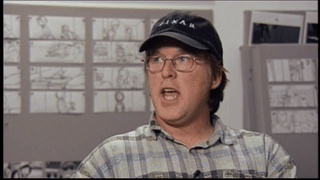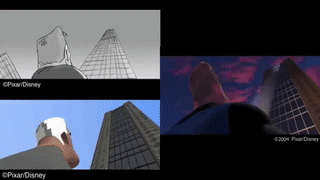#working in the animation industry and in a pipeline sort of reminiscent to how these cartoons were made (like SpongeBob operates with a
Note
What shorts are you most excited to review?
TOO MANY!!! The Great Piggy Bank Robbery for sure will absolutely be my #1 i’m excited for, along with other favorites like Baby Bottleneck and Kitty Kornered… i’ll warn you in advance that i already KNOW those are going to be insanely long because i really want to talk about the most minute details (like watching Piggy Bank the other day i spent about 10 minutes thinking about why does Daffy have a mailbox? does he own the farm? that’s weird if he does. but why would only he have the mailbox if he’s a farm animal? and look! it has his name on it! he used a stencil. there was not at all intended to be so much thought put behind this but the implication is fascinating. these are the kinds of things i like to scrutinize)
HARD TO SAY THOUGH there truly are so many… 99% of the Porky and Daffy entries for sure HAHA. i try to focus on the present, but like… right now, i’m really looking forward to reviewing Porky’s Last Stand, which was the first short of 1940 and one of my favorites—before that i was excited for Wise Quacks, before that The Daffy Doc, etc. i do tend to think in terms of “what’s my next favorite” BUT i’ve learned to love many cartoons i never would have liked had i not dug super deep into them, so it’s really hard to say!! i enjoy surprising myself with shorts i didn’t know i would like in the first place… pretty much all of the Daffy and/or Porky shorts though without a doubt though
#for example Naughty Neighbors is next and i personally think it’s one of Clampett’s worst#but as i was picking through it i was like ‘oh the timing on this is good the contrast is really effective here the layouts are gorgeous ‘#and i found myself liking it giving it that sort of scrutiny more than i would as a normal watcher. i still think it’s a supremely lame#cartoon but having the insight i do now i appreciate it much more#working in the animation industry and in a pipeline sort of reminiscent to how these cartoons were made (like SpongeBob operates with a#director and their team of plussers/revisionists much like a director and his team of animators in the golden age where you’re able to#identify each animator’s style but the director sets the overall tone of the short) so having that sort of hands on experience has been#really enlightening too. so my reviews are sort of written with that background/opinionation in mind#but then again i’m not writing these as scholarly articles and purely objective. i do have my biases for sure and will acknowledge them#absolutely but it would be so fruitless to do otherwise you know? personal voice and opinion matters#IDK WHY I’M PONTIFICATING ABOUT THIS IT’S TANGENTIALLY RELATED HAHAHAHHA BUT#anonymous#asks
13 notes
·
View notes
Photo








Introduction to Storyboarding
Introduced to Storyboarding by Helen Schroeder, she introduced herself as an animator who over the past few years has transitioned into the role of a storyboard developing. Working for various studios throughout the years, her current occupation lies at Locksmith animation, whilst making their first feature film is now in the second year of storyboarding. Discussing and explaining her role within the industry and that particular project, we got a basic understanding by discussing, asking questions and being taught about the impact a storyboard has upon the end result of an animated feature.
Originally developed for Disneys 1963 adaptation of ‘The Sword in the Stone’, the literal storyboard consisted of a physical rendition of the narrative presented on a physical board. As a clear way to digest the films narrative whilst showcasing its flow and themes throughout the film. In the upcoming years and still today this became standard practice for almost all animated features, commercials and even live-action films.
Allowing directors, artists and all involved getting a visual understanding of the complete narrative and the directors original creative vision to the final adaptation of the film or production. Helen discussed in her presentation the importance of storyboarding and how we must consider it in our own work to produce established narratives that reach their full potential.
What is Storyboarding?
The process of editing a film before its made, Helen Schroeder sees storyboarding as the most versatile and rewarding job within the industry roles within a project. Considered as a matter of routine, storyboarding gives us the chance to evidence our original intentions and directions with how we want a scene to play out.
To plot and distinguish the first rendition of timing, storyboarding helps establish a timeline in the production in the hopes of ironing out and sorting out any problems within the narrative before production. So that animators and others in the production line don’t encounter problems down the line its the storyboard artists role to bring a fully realised and complete narrative to life before the end of pre-production.
With the goal of getting everyone on the same page, the role of the storyboard artists is to visualise the script and draw the first vision of the narrative in the form of a list of beats, influencing and feeding on one to another, the storyboard should showcase all the key events and changes that happen in a single scene.
Not the initial board of influence, there will typically be elements of the director's vision already put into place. Typically introduced to characters through character sketches and ideas of location, its the role of the storyboarder to consider the actions of these characters.
The first intention and understanding of the character of a visual level to how they would move, act and react to the given script. The first people to add visual action to the narrative they influence the character's performance, their range of expression and range of emotional distance in conjunction with the direction of the story.
The benefits of working early on throughout production are that you're very much hands on with the director's initial thoughts and vision. With the opportunity to get feedback from the director themselves, its the greatest chance of being able to include your own take, influence and experimentation with the direction of the scenes.
This level of independence grants a better understanding of the character and holds a key influence on how it will pass down amongst the production line to animators and other compositors who put the film together.
As an animator utilising the power of storyboards will allow us to breakdown our outcomes better. Understanding the strength of using key poses to be able to tell a narrative through visual language alone. It will make us think about how we set out our scenes and use elements such as composition and body language throughout our shots. To ensure that our characters are there for a point, this will distinguish how we utilise our characters in their space within the frame to the best advantage.
Art Direction in Storyboards
Art direction is what helps establish what is needed in the scene to help create an atmosphere. Considering what is in the frame needed to tell the story, this could be anything from the layout of a house, where the characters are place on screen, their relationship to one another compositionally and how they balance one another. I have to consider as an animator and a storyboard artist that everything on the screen should serve the story used to build the world around the character and the character themselves.
Supported by the use of cinematogrpahy and camera language, this helps determine the rhythm of the film. It’s at this stage early stage of production where we begin to incorporate the cinematic style, whether that's very distinctive and traditional or follows the influence of a central plane much like Wes Anderson, director of ‘Isle of Dogs’ and ‘Fantastic Mr Fox’. We have to consider how the role of the camera plays a part in the audience's perception of the characters and narrative as a whole. Thematically changing and adapting the story through the use of camera angles.
This was evident in the first ‘Incredibles’, as its understanding of cinematography presented a groundbreaking realism as it very much had a live-action camera feel. Keeping within the stereotypical shots of a live-action superhero movie, director Brad Bird can be seen harking back to specific camera language that presents a more flat and stylised series of shots and movement reminiscent of the early superhero era. This is something that would have and was considered in the earliest stages of storyboarding and remains unchanged.
Treatment > Script > Storyboard > Animatic / Story Reel > Layout > Animation
As a production tool storyboards are used to in a various number of ways, through production they enable the team and director to establish a clear visual vision of the narrative and how it has been adapted to its medium, theme and tone. These are some of the core uses of a storyboard and their roles in the production of a feature film;
Work out the core idea and structure of the project
Visualise action described in a script
Portray physical / Visual gags that can’t be written
Determine the costs and production time of a project
Identify issues in the structure of a script > timing od action in the animatic
Working out Character performance
Communicate: Ensure cohesion across departments and production phases, guide animators, asset creators etc.
Act as a blueprint for the project
Sell the idea to other people (pitch)
To summarise;
I established the roles and importance of a storyboard throughout the production of animation.
Gave a brief overview of Helen Schroeder's use of storyboards in industry.
Discussed how these applications can be applied to my own upcoming work in the project.
Discussed the influence and power of storyboards through pre-production as a visual aid to support animators and others down the pipeline.
Sources;
‘Progression Reel The Incredibles’ Youtube Video
https://www.youtube.com/watch?v=wYzrS4Hqj4c
‘Deleted Scenes - Bob In Traffic’ Youtube Video
https://www.youtube.com/watch?v=dTYUTzGLRjc
0 notes